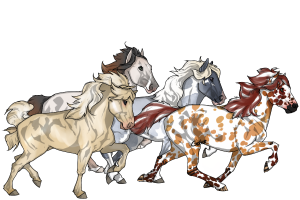Main Archives ~ Breeding Archives
Snare-Horned Gazelle are named for the males' long horns that curve under their chest and belly. The horns were developed to defend against their natural predator, the African Grinning Hounds that went for chest and belly bites to weaken and kill. (click the link to adopt your own hound!)
Habitat- Snare horns live on the African plains alongside other gazelle and antelope. They were hunted to near extinction for their horns, and the species is making a come back due to their growing popularity as domesticated animals.
Description:
Males (Bulls)- Males have humped backs and a double set of horns. The longer "snare" set (so named for the way they encircle the creature's front legs) protect them from the killing bites of predators that they often chase away from the herd. The smaller set is used in fights over mates and defending territory.
Females(Cows)- Females have no hump and one set of smaller horns to defend themselves and their calves.
Wild:In the wild Snare-Horns live in herds of 15-20 animals, with the majority of the group being females and calves, and 3 or 4 adult males traveling with them. There is usually a matriarch female that will lead the nomadic herd as they amble along, and the males will spread out along the sides and rear to watch for predators. During the rut males within a herd will fight to establish a pecking order, and the dominant male will have first breeding rights to females in the herd. The lower males will drive off young bachelors seeking to snag females from the group, and they have breeding rights to those cows that the dominant male does not claim. Wild Snare-Horns join the annual great migration that the wildebeest and zebra of the African plains lead, following the rains to find better grazing.
Domesticated: Snare-horns are growing in popularity as domestic live stock animals. Both bulls and cows make good harness animals, and cows can be used under saddle as well. Many owners of domesticated Snare-horns are starting to rid bulls of their larger set of horns by de-horning when they are calves, making it easier to fit harness and saddles onto them. However, there are those that prefer to use them in the halter ring where nice horns earn extra points, and they will let them grow to full length.
Rules:
-You may adopt one gazelle every 7 days. You can apply for multiple gazelle, but you will only win up to one a week
-do not claim the species as your own
-Do not modify the design of your Snare-Horned Gazelle. Customs may be open occasionally.
-Do not ask for customs unless otherwise stated
-do not ask to be a moderator/ artist. I will pick them as needed.
-Unless you have permission from the SHG's owner, don't use the creature's image in any way, shape, or form.
-Do not remove my signature
-Adoption forms may not be 'prettied up' unless other wise stated (no color, centering, etc.)
-You may take your SHG off of CS, but do not use as your own adoptable/species, etc.
-If you wish to transfer the ownership of your snare-horn you must notify me via PM. It will be put up for re-adoption.
Ownership/Adopting:
Each Snare horn will have a form to fill out if it is up for adoption (those up for adoption will have a sign that says 'adopt me' on their image). Do not add anything more other than what the form asks for.
For now each Snare horn can breed a total of 5 times (this may be raised later). To get a breeding you'll need to check and see if breedings are open (breeding page under construction) and fill out the provided form. You will need permission from the owner(s) of the snare horns you do not own if you wish to breed them
Colors- SHG's come in all the same base colors a horse can, as well as those of various African gazelle and antelope species.
Marking sets- The most common marking set is the gemsbok mask and belly stripe. They can also bare the markings of prong-horned antelope and springbok gazelle.
Some SHG's have no additional marking sets.
(more making sets will be added as adoptables are made)
Barring/Quipping- SHG's will always have some form of barring or quipping, even if it is very minimal such as leg barring or ear barring. The stripes can come in many different colors and patterns



























